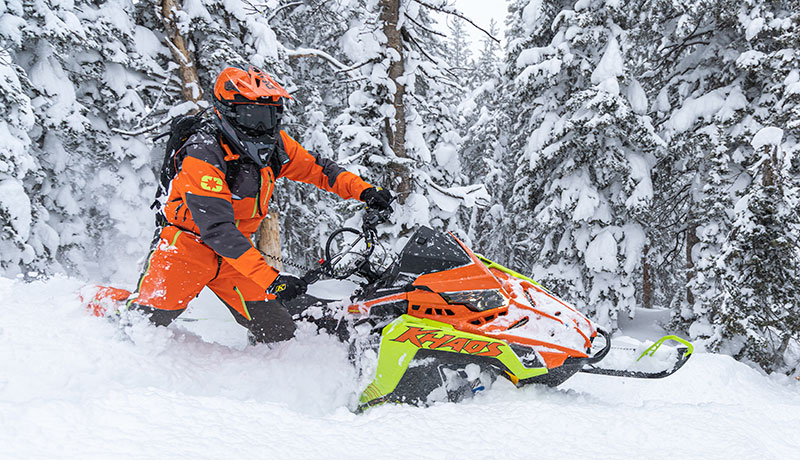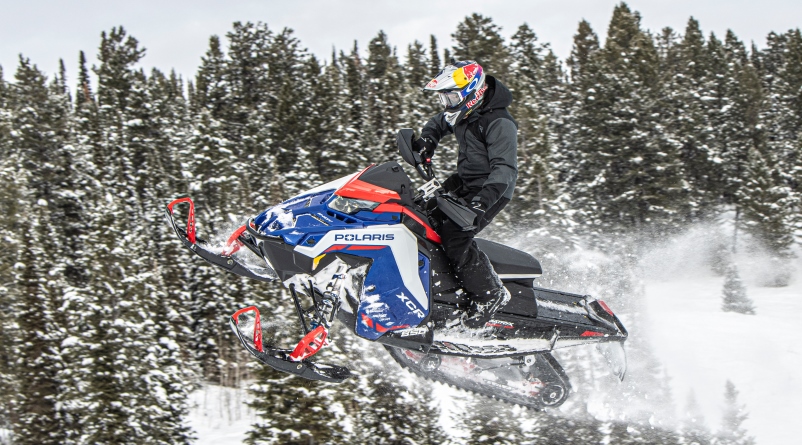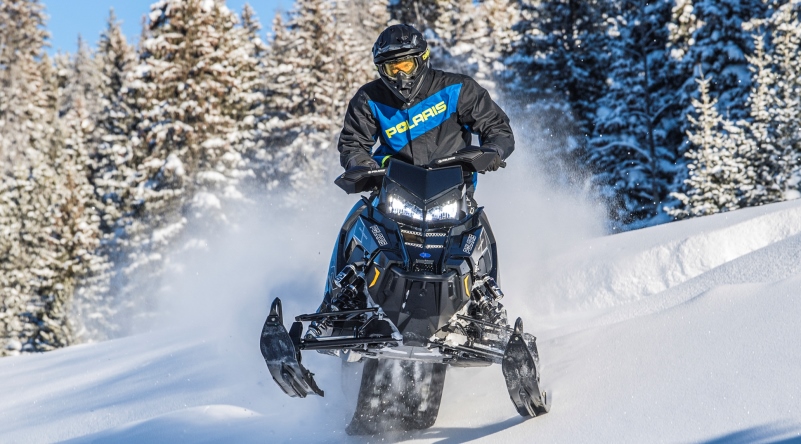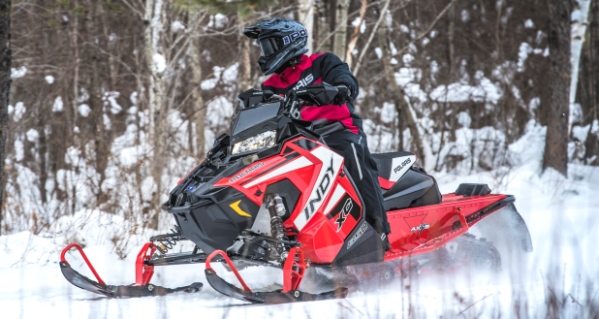 Five years ago, a select group of western dealers was gathered at Polaris’ Roseau, Minnesota, headquarters for a sneak-preview of what would be the 2007 Dragon RMK. The Polaris engineers were proud of the mountain sled they’d be introducing the following spring, but because they were also charged with planning five-plus years ahead, part of their attention had already turned to “what’s next.”
Five years ago, a select group of western dealers was gathered at Polaris’ Roseau, Minnesota, headquarters for a sneak-preview of what would be the 2007 Dragon RMK. The Polaris engineers were proud of the mountain sled they’d be introducing the following spring, but because they were also charged with planning five-plus years ahead, part of their attention had already turned to “what’s next.”
The engineers had their own feelings over the future of the RMK brand, and some concepts were already in motion for 2011. But they decided to ask the assembled dealers, who live and ride in top Western playgrounds, their opinions. All Polaris officials exited the room, leaving the dealers with a white board to write down all of their ideas.
“It was awesome for us because when we came back about two hours later, we walked into the room and there were just three statements on the board – no specifics whatsoever,” said Marty Sampson, project leader for the Polaris RMKs. “They said ‘Make it light, make it simple, make it work.’ And that became our defining mantra for this sled.”
Since then, a team of Polaris engineers and designers has toiled with the RMK project, painfully sweating out every tiny detail. The end result is stunning – a high-tech marvel in the 800 Pro-RMK 155 that’s 41 pounds lighter, more powerful and better balanced than the popular 800 Dragon RMK it replaces. More importantly, it sets new standards for climbing and boondocking, performing best where it matters most.
Through it all, however, Polaris engineers kept the dealers’ edict in mind – and they made their new RMK lighter and simple, and they made it work.
Start With A Strong Base
The new 800 Pro-RMK 155 is a new sled in every sense – from the base frame hidden below the plastic to the wide Pro Taper handlebars, the narrow seat and the cut-out snowflap. Now that it’s finished, it weighs just 431 pounds, Polaris says, making it the lightest, mass-produced 800-class mountain machine available.
In addition, the machine features a coil-over rear suspension that Polaris officials say gets up on top of the snow more easily and floats better, while improving handling, maneuverability and climbing capabilities. Our testing confirmed their claims.
Planning for the base chassis, which includes a cast bulkhead and strong overstructure, started “eight or nine years long ago,” according to Sampson, as tooling and manufacturing considerations mandated that the RMKs share a backbone with the short-track machines – first unveiled in the 2010 Rush.
The RMK design team, led by Sampson along with Design/Project Engineer Anthony Ripley and Engineering Manager Scott Ostroski but including up to a dozen others, took the light/simple/make it work advice to heart, but had to break that down into hard goals. Some were easy to measure, like power and weight goals, chassis stiffness, durability of components, etc. Other criteria, like handling, maneuverability and the all-important “balance,” were more subjective.
Richard Simmons Would Be Proud
It’s been said that, when a person wants to lose serious weight and keep it off, he or she has to make permanent changes to diet and lifestyle – there’s no easy solution. Losing weight on a snowmobile is similar. Every part on the machine and its role must be examined. Losing 6.1 pounds from the exhaust was nice, but the real gain came from losing 6 ounces here, 8 ounces there and 11 ounces somewhere else – and adding them all up.
“The thing that we know as a team is that if you don’t scrutinize absolutely every part you put on the thing, you’ll never get there,” Sampson said. “You take every part and you scrutinize and engineer your way through the weight loss. It’s definitely not a pick and choose sort of thing – it doesn’t work that way.”
Examples of weight loss are everywhere. Rivets, welds, nuts and bolts were replaced with structural bonding; duplicate material in the tunnel was stamped out; steel was replaced by aluminum; the new silencer is smaller and much lighter; the plastic cover was removed from the front bumper, eliminating a couple of ounces; the rear bumper is made of carbon fiber; holes were trimmed in the snow flap.
For structural changes, engineers were tasked with making all parts and connections at least as strong, if not stronger, than the parts they replaced. They claim the chassis is 300 percent stiffer than the IQ chassis it replaced, and that’s important not just for durability but for improved handling.

Weight loss in the brake system is a prime example. It starts at the new, smaller chaincase – a design introduced on last year’s 600 Rush. On the RMK, it’s attached to a hollow jackshaft and a lightweight wave rotor that’s drilled out with dozens of holes. Gripping that is a single-piston brake caliper. All totaled, 2.5 pounds were eliminated in the jackshaft and caliper alone.
All of this weight loss may sound simple, but there’s a lot of engineering involved. Sampson and Ripley said designing the right running board tube took six-months, for example.
The Skid: Lighter & Better
The rear suspension is to a mountain snowmobile what an arm is to a pitcher, a bribe (OK, targeted political donation) is to a lobbyist and a memorable guitar riff is to a classic rock-n-roll song: It’s got to be good, or all the rest just doesn’t matter.
Any snowmobile rear suspension must absorb energy, but the rear suspension on a mountain sled is also tasked with grabbing traction in varying conditions; immediately pulling the machine up on top of powdery snow and defining flotation; clawing up a steep incline or through the trees; providing easy handling in powder or on hardpack; and responding to the driver’s various inputs. Therefore, Polaris engineers spent years defining and refining the RMK Coil-Over rear suspension found on the Pro-RMK.
“I have a strong opinion that the rear suspension is for sure what makes a mountain sled work or not work,” Sampson said. A lot of time was spent with various Computer-Assisted Design (CAD) programs, simulating various situations, but that could only take the designers so far.
“Computer designing is really good guidance,” Ripley said, “but without the guys with experience who have been out and done the riding, and have the experience to know how the sled reacts, the computer is almost useless.
“We’re a tight group, and so the guy that is driving the CAD is also driving the sled,” added Ostroski.
Polaris wasn’t the first to go away from torsion springs in the rear suspension of its mountain machines, but they did it differently.
“Our coil-over is not the same coil-over that everybody else has,” Sampson said, “and that’s based on torque arm lengths and mounting locations and motion ratios. So the front torque arm is substantially longer than anything that’s out there, and it makes it act differently.”
Achieving Balance
While the rear suspension is vital, so is a more nebulous term the RMK team refers to as “balance.”
“You achieve balance by making sure your rider’s in the right spot and interacting with the sled properly,” Sampson said. “Part of balance is about having handlebars that rotate in the right plane. So our steering posts are stood up more on our mountain sleds, while they are laid down more to get out of your way in a corner on our trail performance sleds. We stand the post up to make it more vertical, so that when you’re sidehilling or jumping or coming around on the sled and counter-steering, the bars are more square with your shoulders.
A rider-forward design may be desired on a trail sled, the RMK team stressed, but putting the rider too far forward can seriously mess up the balance on a mountain sled.
“Having the footrests on the right spot on the tunnel puts you in a neutral position so you’re at a pivot point on the sled,” Sampson said, making the sled more open and reactive to driver inputs.
“That’s part of the RMK DNA,” Snowmobile Product Manager Chris Wolf added. “You know, when we developed the sled, it still had to be an RMK. And balance is something that we’ve always been very proud of, it’s a characteristic of our sleds.”
The Finished Product
All four manufacturers have been one-upping one another in the mountains since the first true mountain sled (Ski-Doo’s 1994 Summit) was introduced. The competition is stiff.
That said, our testing last spring in the mountains of Montana found the new RMK has moved Polaris back to the top of the heap, thanks to a design that is light and simple. And it works.
— John T. Prusak






